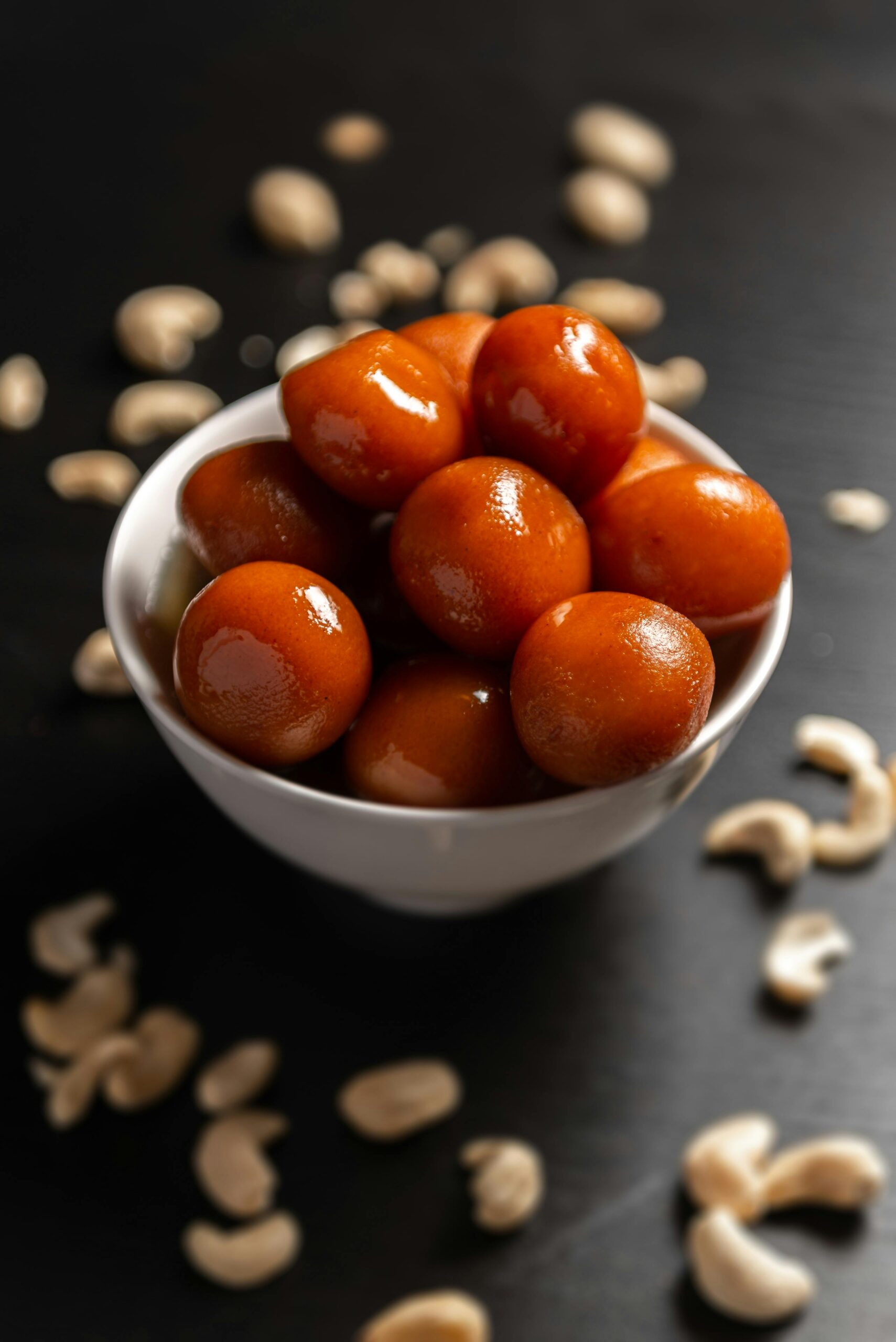Gulab Jamun: A Timeless Indian Delight
Gulab Jamun is one of India’s most cherished and iconic desserts, adored by people of all ages. With its soft, melt-in-the-mouth texture and rich, syrupy sweetness, this dessert has found its way into every festive occasion, celebration, and even daily indulgence.
The Origins of Gulab Jamun
Gulab Jamun has a fascinating history that traces back to Persia and the Middle East. The name “Gulab Jamun” is derived from Persian words—gulab (rose water) and jamun (a small Indian fruit resembling the dessert in shape and color).”It is believed that this delicacy was introduced to India by the Mughals.

Ingredients and Preparation
Ingredients:
To make traditional Gulab Jamun, you will need:
- For the dough:
- 1 cup khoya (reduced milk solids)
- 3 tablespoons all-purpose flour (maida)
- 1/4 teaspoon baking soda
- 2 tablespoons milk (as needed for kneading)
- 1 teaspoon ghee (clarified butter)
- For the sugar syrup:
- 1 1/2 cups sugar
- 1 1/2 cups water
- 1/2 teaspoon cardamom powder
- 1 teaspoon rose water
- A few saffron strands (optional)
- 1 teaspoon lemon juice (to prevent crystallization)
- For frying:
- Ghee or oil (for deep frying)
Preparation:
- Prepare the Sugar Syrup:
- In a saucepan, mix sugar and water and bring it to a boil.
- Add cardamom powder, rose water, saffron strands, and lemon juice.
- Simmer for 5-7 minutes until the syrup becomes slightly stickyy. Keep it warm.
- Prepare the Dough:
- In a bowl, mix khoya, all-purpose flour, baking soda, and ghee.
- Knead gently, adding milk little by little to form a smooth, soft dough.
- Cover and let it rest for 10 minutes.
- Shape the Gulab Jamun:
- Divide the dough into small equal portions and roll them into smooth balls without cracks.
- Fry the Gulab Jamun:
- Heat ghee or oil in a deep pan on low to medium heat.
- Fry the balls gently, stirring continuously for even cooking until they turn golden brown.
- Remove from oil and drain excess grease on paper towels.
- Soak in Sugar Syrup:
- Place the fried Gulab Jamun into the warm sugar syrup.
- Let them soak for at least 2 hours, allowing them to absorb the flavors.
- Serve and Enjoy:
- Serve warm or chilled, garnished with chopped nuts like pistachios or almonds.
Varieties of Gulab Jamun
While the traditional version remains a favorite, several variations of Gulab Jamun have emerged over time. Some popular types include:
- Kala Jamun: A darker, richer version where the outer layer is almost blackened for a caramelized taste.
- Stuffed Gulab Jamun: Filled with dry fruits, coconut, or even chocolate for a modern twist.
- Paneer Gulab Jamun: Prepared using paneer (cottage cheese), adding a unique texture and taste to the dessert.
- Gulab Jamun with Ice Cream: A contemporary fusion where warm Gulab Jamun is served with a scoop of vanilla or saffron-flavored ice cream for a delightful contrast.
Caloric and Nutritional Information
As delicious as Gulab Jamun is, it is also a calorie-dense dessert. The deep-fried and sugar-soaked nature of this dish makes it a high-energy food, often consumed in moderation.
- Calories per piece (40g): Approximately 150-180 kcal
- Carbohydrates: 30-35g (mainly from sugar and flour)
- Fats: 6-8g (due to deep frying in ghee or oil)
- Proteins: 2-3g (from milk solids and flour)
- Sugar content: Around 20g per piece
Due to its high sugar and fat content, it is recommended to enjoy Gulab Jamun in moderation, especially for those watching their calorie intake, managing diabetes, or following a low-sugar diet. However, healthier versions can be made using reduced sugar syrup, baking instead of deep-frying, or using alternative ingredients like whole wheat flour or jaggery.
Cultural Significance
Gulab Jamun is more than just a dessert; it holds cultural and emotional significance in Indian households. Be it Diwali, weddings, or family gatherings, no celebration is complete without this delectable treat. It is often served alongside other Indian sweets like jalebi and rasgulla, forming a delightful part of traditional Indian cuisine.
In many Indian traditions, offering sweets is a symbol of happiness, prosperity, and togetherness. Gulab Jamun is also a popular dessert at temples and religious events, where it is distributed as prasad (a sacred offering). In modern times, it has even gained global recognition, appearing on menus in Indian restaurants worldwide.
Conclusion
“Whether enjoyed warm or cold, Gulab Jamun continues to delight dessert lovers worldwide. Moreover, its rich history and deep cultural significance make it a true culinary masterpiece.
The next time you savor a piece of Gulab Jamun, take a moment to appreciate its tradition, craftsmanship, and the love infused into every bite. Additionally, sharing this delectable sweet with family and friends enhances the joy, making every celebration even more special.”
This version improves readability, incorporates relevant keywords like “Gulab Jamun,” “dessert lovers,” “culinary masterpiece,” and “celebration”.
